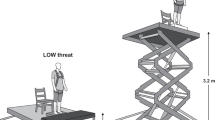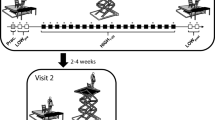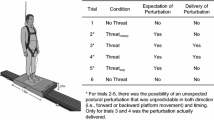Abstract
Anxiogenic settings lead to reduced postural sway while standing, but anxiety-related balance may be influenced by the location of postural threat in the environment. We predicted that the direction of threat would elicit a parallel controlled manifold relative to the standing surface, and an orthogonal uncontrolled manifold during standing. Altogether, 14 healthy participants (8 women, mean age = 27.5 years, SD = 8.2) wore a virtual reality (VR) headset and stood on a matched real-world walkway (2 m × 40 cm × 2 cm) for 30 s at ground level and simulated heights (elevated 15 m) in two positions: (1) parallel to walkway, lateral threat; and (2) perpendicular to walkway, anteroposterior threat. Inertial sensors measured postural sway acceleration (e.g., 95% ellipse, root mean square (RMS) of acceleration), and a wrist-worn monitor measured heart rate coefficient of variation (HR CV). Fully factorial linear-mixed effect regressions (LMER) determined the effects of height and position. HR CV moderately increased from low to high height (p = 0.050, g = 0.397). The Height × Position interaction approached significance for sway area (95% ellipse; β = − 0.018, p = 0.062) and was significant for RMS (β = − 0.022, p = 0.007). Post-hoc analyses revealed that sagittal plane sway accelerations and RMS increased from low to high elevation in parallel standing, but were limited when facing the threat during perpendicular standing. Postural response to threat varies depending on the direction of threat, suggesting that the control strategies used during standing are sensitive to the direction of threat.






Similar content being viewed by others
Availability of data and material
All data are available here: https://github.com/keithlohse/Gait_VR/tree/master/standing_balance.
Code availability
All analysis code are available here: https://github.com/keithlohse/Gait_VR/tree/master/standing_balance.
Notes
HTC Vive versions were switched to version 2.0 after the first six participants to increase the number of lighthouses (i.e., infrared tracking stations) from two to four and improve tracking quality.
References
Adkin AL, Carpenter MG (2018) New insights on emotional contributions to human postural control. Front Neurol 9:789. https://doi.org/10.3389/fneur.2018.00789
Adkin AL, Frank JS, Carpenter MG, Peysar GW (2000) Postural control is scaled to level of postural threat. Gait Posture 12:87–93. https://doi.org/10.1016/S0966-6362(00)00057-6
Adkin AL, Campbell AD, Chua R, Carpenter MG (2008) The influence of postural threat on the cortical response to unpredictable and predictable postural perturbations. Neurosci Lett 435:120–125. https://doi.org/10.1016/j.neulet.2008.02.018
Bakshi A, Dizio P, Lackner JR (2019) Adaptation to coriolis force perturbations of postural sway requires an asymmetric two-leg model. J Neurophysiol 121:2042–2060. https://doi.org/10.1152/jn.00607.2018
Bates D, Mächler M, Zurich E et al (2015) Fitting linear mixed-effects models using lme4
Bles W, Kapteyn TS, Brandt T, Arnold F (1980) The mechanism of physiological height vertigo II. Posturography. Acta Otolaryngol 89:534–540. https://doi.org/10.1017/CBO9781107415324.004
Boroomand-Tehrani A, Huntley AHAB-TAH, Jagroop D et al (2019) The effects of postural threat induced by a virtual environment on performance of a walking balance task. bioRxiv. https://doi.org/10.1101/752139
Brandt T, Arnold F, Bles W, Kapteyn TS (1980) The mechanism of physiological height vertigo I. Theoretical approach and psychophysics. Acta Otolaryngol 89:513–523
Brown LA, Polych MA, Doan JB (2006) The effect of anxiety on the regulation of upright standing among younger and older adults. Gait Posture 24:397–405. https://doi.org/10.1016/j.gaitpost.2005.04.013
Carpenter MG, Frank JS, Silcher CP (1999) Surface height effects on postural control: a hypothesis for a stiffness strategy for stance. J Vestib Res Equilib Orientat 9:277–286
Carpenter MG, Frank JS, Silcher CP, Peysar GW (2001) The influence of postural threat on the control of upright stance. Exp Brain Res 138:210–218. https://doi.org/10.1007/s002210100681
Cleworth TW, Horslen BC, Carpenter MG (2012) Influence of real and virtual heights on standing balance. Gait Posture 36:172–176. https://doi.org/10.1016/J.GAITPOST.2012.02.010
Cleworth TW, Chua R, Inglis JT, Carpenter MG (2016) Influence of virtual height exposure on postural reactions to support surface translations. Gait Posture 47:96–102. https://doi.org/10.1016/j.gaitpost.2016.04.006
Cohen J (1988) Statistical power analysis for the behavioral sciences, 2nd edn. Lawrence Erlbaum Associates, New York
Cumming G (2012) Cohen’s d. In: Understanding the new statistics: effect sizes, confidence intervals, and meta-analysis. Routledge, pp 281–320
Cusumano JP, Dingwell JB (2013) Movement variability near goal equivalent manifolds: fluctuations, control, and model-based analysis. Hum Mov Sci 32:899–923. https://doi.org/10.1016/j.humov.2013.07.019
Ehgoetz Martens KA, Ellard CG, Almeida QJ (2015) Virtually-induced threat in Parkinson’s: dopaminergic interactions between anxiety and sensory–perceptual processing while walking. Neuropsychologia 79:322–331. https://doi.org/10.1016/J.NEUROPSYCHOLOGIA.2015.05.015
Gendre M, Yiou E, Gélat T et al (2016) Directional specificity of postural threat on anticipatory postural adjustments during lateral leg raising. Exp Brain Res 234:659–671. https://doi.org/10.1007/s00221-015-4471-x
Hedges LV (1981) Distribution theory for glass’s estimator of effect size and related estimators. J Educ Stat 6:107–128
Johnson KJ, Zaback M, Tokuno CD et al (2019) Repeated exposure to the threat of perturbation induces emotional, cognitive, and postural adaptations in young and older adults. Exp Gerontol 122:109–115. https://doi.org/10.1016/j.exger.2019.04.015
Latash M, Levin M, Scholz J, Schöner G (2010) Motor control theories and their applications. Medicina (B Aires) 46:382. https://doi.org/10.3390/medicina46060054
Lee GC (2019) Full immersion virtual reality: adverse effects related to static balance. Neurosci Lett. https://doi.org/10.1016/j.snb.2019.127065
Lo OY, van Donkelaar P, Chou LS (2015) Distracting visuospatial attention while approaching an obstacle reduces the toe-obstacle clearance. Exp Brain Res 233:1137–1144. https://doi.org/10.1007/s00221-014-4189-1
Mancini M, Salarian A, Carlson-Kuhta P et al (2012) ISway: a sensitive, valid and reliable measure of postural control. J Neuroeng Rehabil 9:1. https://doi.org/10.1186/1743-0003-9-59
Martens MA, Antley A, Freeman D et al (2019) It feels real: physiological responses to a stressful virtual reality environment and its impact on working memory. J Psychopharmacol. https://doi.org/10.1177/0269881119860156
Moe-Nilssen R (1998) A new method for evaluating motor control in gait under real-life environmental conditions. Part 1: the instrument. Clin Biomech 13:320–327
Peterson SM, Furuichi E, Ferris DP (2018) Effects of virtual reality high heights exposure during beam-walking on physiological stress and cognitive loading. PLoS One 13:1–18. https://doi.org/10.1371/journal.pone.0200306
Phanthanourak AL, Cleworth TW, Adkin AL et al (2016) The threat of a support surface translation affects anticipatory postural control. Gait Posture 50:145–150. https://doi.org/10.1016/j.gaitpost.2016.08.031
R Core Team (2019) R: a language and environment for statistical computing
Raffegeau TE, Fawver B, Clark M, Engel BT, Young WR, Williams AM, Lohse KR, Fino PC (2020) The feasibility of using virtual reality to induce mobility-related anxiety during turning. Gait Posture 77:6–13. https://doi.org/10.1016/j.gaitpost.2020.01.006
Scholz JP, Schöner G (1999) The uncontrolled manifold concept: identifying control variables for a functional task. Exp Brain Res 126:289–306. https://doi.org/10.1007/s002210050738
Tokuno CD, Keller M, Carpenter MG et al (2018) Alterations in the cortical control of standing posture during varying levels of postural threat and task difficulty. J Neurophysiol 120:1010–1016. https://doi.org/10.1152/jn.00709.2017
Wang Z, Newell KM (2012) Asymmetry of foot position and weight distribution channels the inter-leg coordination dynamics of standing. Exp Brain Res 222:333–344. https://doi.org/10.1007/s00221-012-3212-7
Winter DA (1995) Human blance and posture control during standing and walking. Gait Posture 3:193–214. https://doi.org/10.1016/0966-6362(96)82849-9
Worden TA, Mendes M, Singh P, Vallis LA (2016) Measuring the effects of a visual or auditory Stroop task on dual-task costs during obstacle crossing. Gait Posture 50:159–163. https://doi.org/10.1016/j.gaitpost.2016.08.033
Wuehr M, Breitkopf K, Decker J et al (2019) Fear of heights in virtual reality saturates 20 to 40 m above ground. J Neurol 266:80–87. https://doi.org/10.1007/s00415-019-09370-5
Young WR, Williams AM (2015) How fear of falling can increase fall-risk in older adults: applying psychological theory to practical observations. Gait Posture 41:7–12. https://doi.org/10.1016/j.gaitpost.2014.09.006
Zaback M, Carpenter MG, Adkin AL (2016) Threat-induced changes in attention during tests of static and anticipatory postural control. Gait Posture. https://doi.org/10.1016/j.gaitpost.2015.12.033
Acknowledgements
We would like to acknowledge the hard work of the students that made this work possible including Mindie Clark, Nick Kreter, and Ashlee McBride.
Funding
PCF was supported by the Eunice Kennedy Shiver National Institute of Child Health and Human Development of the National Institutes of Health under Award Number K12HD073945. The content is solely the responsibility of the authors and does not necessarily represent the official views of the National Institute of Health.
Author information
Authors and Affiliations
Contributions
WRY, AMW, PCF, KRL and BF contributed to the study conception and design. Material preparation and data collection were performed by TER. Hypothesis development and data analysis were completed by TER and PCF. Statistical analysis was conducted by TER and KRL. The first draft of the manuscript was written by TER and all authors commented and contributed to all versions of the manuscript. Figures and manuscript revisions were managed by TER, BF, and PCF. All authors read and approved the final manuscript.
Corresponding author
Ethics declarations
Conflict of interest
The authors have no conflict of interest. Material has been reviewed by the Walter Reed Army Institute of Research. There is no objection to its presentation and/or publication. The opinions or assertions contained herein are the private views of the author, and are not to be construed as official, or as reflecting true views of the Department of the Army or the Department of Defense. The investigators have adhered to the policies for protection of human subjects as prescribed in AR 70–25.
Ethics approval
All procedures in this study were approved by the University of Utah IRB.
Consent to participate
All participants provided informed consent in accordance with the Declaration of Helsinki.
Additional information
Communicated by Francesco Lacquaniti.
Publisher's Note
Springer Nature remains neutral with regard to jurisdictional claims in published maps and institutional affiliations.
Electronic supplementary material
Below is the link to the electronic supplementary material.
Rights and permissions
About this article
Cite this article
Raffegeau, T.E., Fawver, B., Young, W.R. et al. The direction of postural threat alters balance control when standing at virtual elevation. Exp Brain Res 238, 2653–2663 (2020). https://doi.org/10.1007/s00221-020-05917-5
Received:
Accepted:
Published:
Issue Date:
DOI: https://doi.org/10.1007/s00221-020-05917-5




